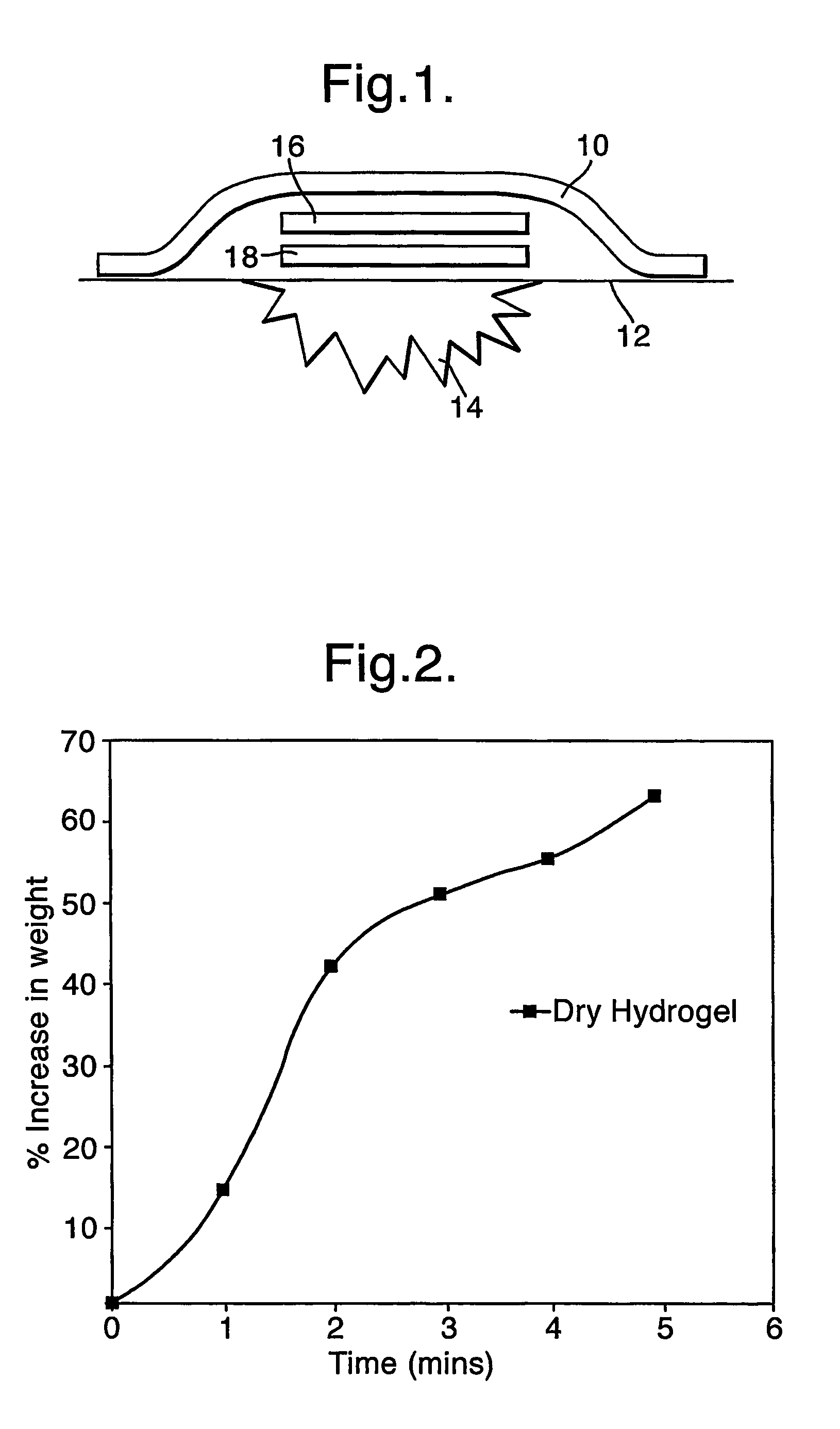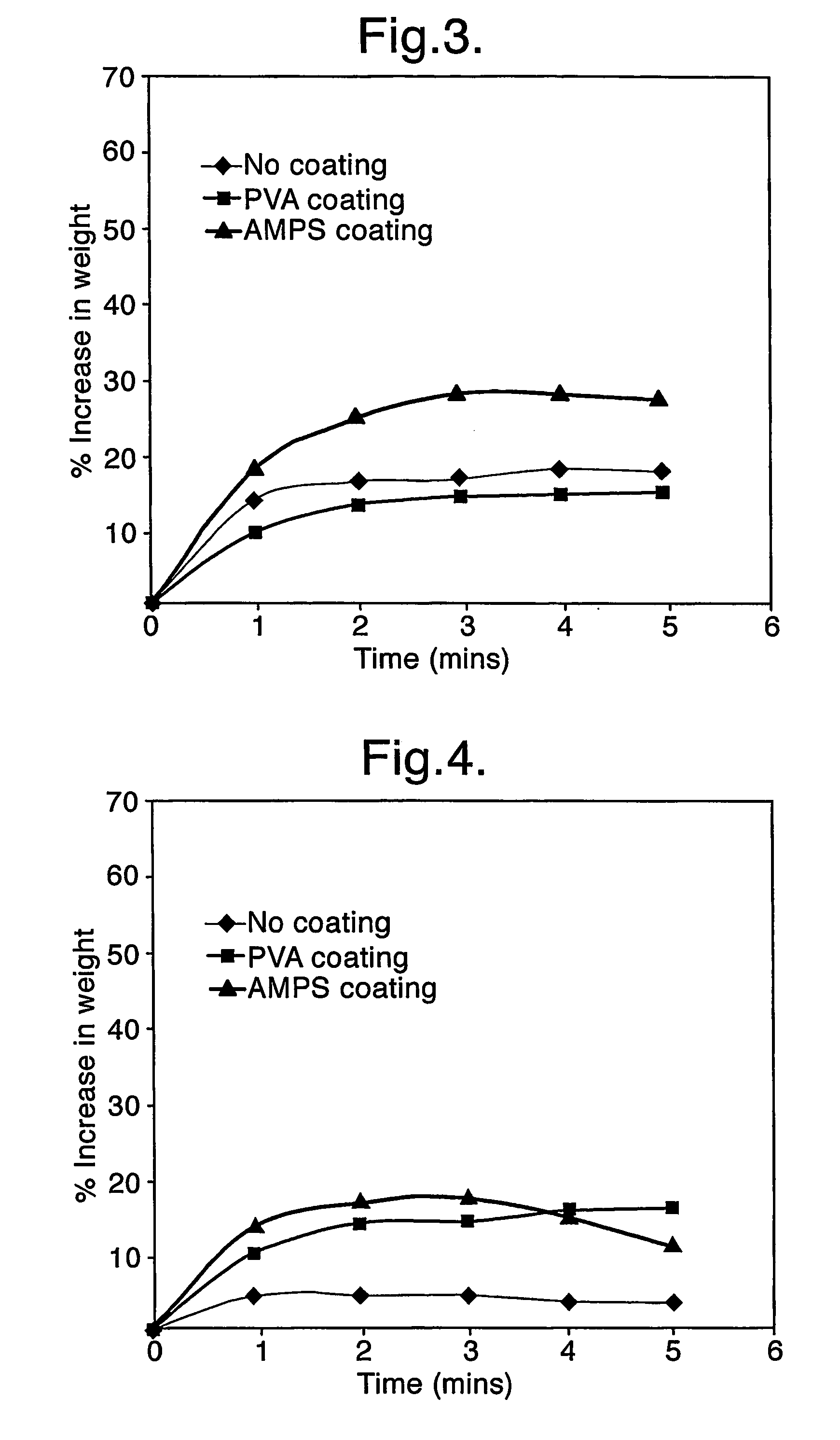Skin dressings containing oxidoreductase enzyme
a technology of oxidoreductase and skin, applied in the field of skin dressings, can solve the problems of not offering all of the much desired characteristics, reducing the overall time during which a wound needs attention, and almost impossible to design an ideal wound dressing, so as to prevent the build-up of potentially damaging hydrogen peroxide, break down excess hydrogen peroxide, and improve wound healing
- Summary
- Abstract
- Description
- Claims
- Application Information
AI Technical Summary
Benefits of technology
Problems solved by technology
Method used
Image
Examples
experiment 1
[0100]Experiments were carried out using the dried hydrogel material used for the first component 16 (referred to as layer 1) and the hydrated hydrogel material used for the second component 18 (referred to a layer 2), to demonstrate restoration of the activity of the dried enzyme in layer 1 on rehydration with water stored in layer 2. This involved the use of indicator plates prepared as follows:
[0101]1% agar (Sigma) and 1% starch (Aldrich) was dissolved in DI-water. 100 mM potassium iodide (Fisher) was then added, and the molten gel poured into disposable petri dishes to a depth of 2-3 mm. The gels were allowed to cool.
[0102]A sheet of layer 1 hydrogel was dried in an oven at 37° C. for 1 hour. 4 cm×4 cm blocks of layer 2 were placed onto indicator plates. To the top of these, either the dried or non-dried layer 1 sheet was added. The rate of colour change was observed as an indicator of how quickly the glucose oxidase is producing hydrogen peroxide. The colour change is due to th...
experiment 2
[0105]Further experiments were carried out using different supports for the dried enzyme layer 1, together with a hydrated hydrogel layer 2 as previously described.
[0106]Glucose oxidase was prepared in DI-water, 3% w / v polyvinyl alcohol and AMPS monomer at 14 U / ml. Cotton gauze and Whatman No. 1 blotting paper were saturated with each of the solutions and dried at 37° C. A section of each material of each glucose oxidase (GOX) preparation was then applied to a layer 2 gel, on an indicator plate. Also used where the layer 1 hydrogels described in experiment 1. The samples were observed for colour change (i.e. perceived activity) and wetting. The observations are seen in Table 2 and Table 3 respectively.
[0107]
TABLE 2perceived activity after combination of layer 1 and layer 2.Gox inGox inGox inGox inGox inGox inGox inGox inwaterwaterPVAPVAAMPSAMPSh / gelh / gelTime (mins)GauzePaperGauzePaperGauzePaperWetDried1————————15————xxxx30xxxxxxxxxxxx45xxxxxxxxxxxxxxxxxxxxxx
[0108]
TABLE 3observed wet...
experiment 3
[0111]Further experiments were carried out using different materials for the first component 16, i.e. the upper layer of the dressing. In particular, different support materials (absorbent filter paper, cotton gauze and dry poly-AMPS) were used for carrying dried glucose oxidase enzyme, with and without PVA and AMPS as hydration enhancers. The water uptake properties of the different materials on contact with a hydrated Na poly-AMPS hydrogel (second component 18) were examined.
[0112]The following experimental first component layers were prepared:[0113]Layer A) Absorbent filter paper[0114]Layer B) Absorbent filter paper coated in PVA, with PVA used at 3% w / v[0115]Layer C) Absorbent filter paper coated in Na AMPS monomer, with Na AMPS monomer used at 20-25% w / v[0116]Layer D) Cotton gauze[0117]Layer E) Cotton gauze coated in PVA, with PVA used at 3% w / v[0118]Layer F) Cotton gauze coated in Na AMPS monomer, with Na AMPS monomer used at 20-25% w / v[0119]Layer G) Dry poly Na-AMPS
[0120]The ...
PUM
| Property | Measurement | Unit |
|---|---|---|
| depth | aaaaa | aaaaa |
| temperature | aaaaa | aaaaa |
| hydrophilic | aaaaa | aaaaa |
Abstract
Description
Claims
Application Information
 Login to View More
Login to View More - R&D
- Intellectual Property
- Life Sciences
- Materials
- Tech Scout
- Unparalleled Data Quality
- Higher Quality Content
- 60% Fewer Hallucinations
Browse by: Latest US Patents, China's latest patents, Technical Efficacy Thesaurus, Application Domain, Technology Topic, Popular Technical Reports.
© 2025 PatSnap. All rights reserved.Legal|Privacy policy|Modern Slavery Act Transparency Statement|Sitemap|About US| Contact US: help@patsnap.com


